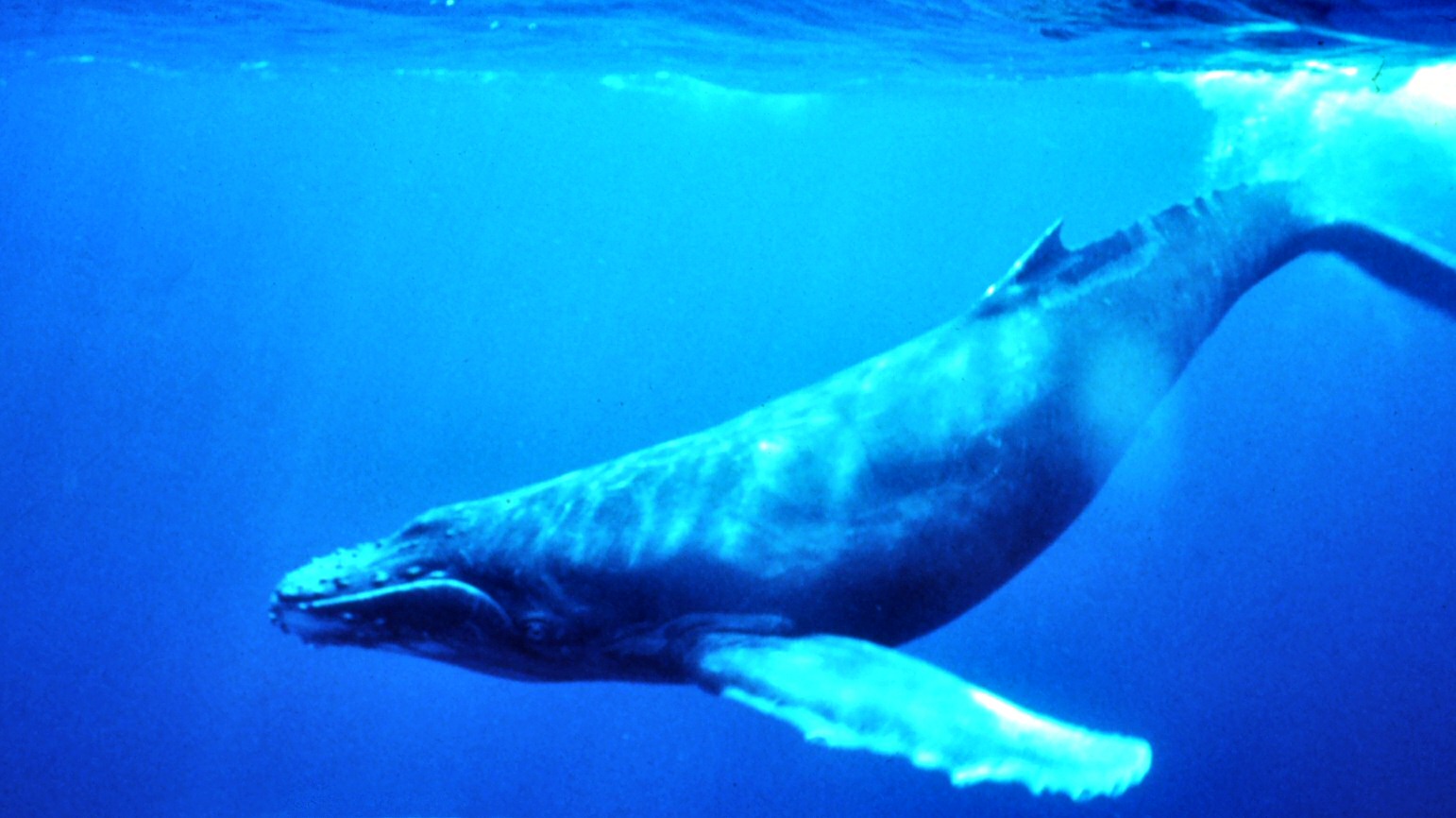- Rorqual
Taxobox
name = RorqualsMSW3 Cetacea|id=14300010]

image_caption =Humpback Whale , "Megaptera novaeangliae"
regnum =Animal ia
phylum = Chordata
classis =Mammal ia
ordo =Cetacea
subordo =Mysticeti
familia = Balaenopteridae
familia_authority = Gray, 1864
subdivision_ranks = Genera
subdivision = "Balaenoptera "
"Megaptera"Rorquals (pron-en|ˈrɔrkwəl) are the largest group of
baleen whale s, with ninespecies in two genera. They include the largest animal that has ever lived, theBlue Whale , which can reach 150tonne s, and two others that easily pass 50 tonnes; even the smallest of the group, theNorthern Minke Whale , reaches 9 tonnes.Characteristics
Rorquals take their name from the Norwegian word "röyrkval", meaning "furrow whale". [cite web|url=http://www.iberianature.com/trivia/etymology_mammals.htm | title = Etymology of mammal names | publisher = IberiaNature - Natural history facts and trivia | accessdate = 2006-12-07] All members of the family have a series of longitudinal folds of skin running from below the mouth back to the navel (except the
Sei Whale , which has shorter grooves). These are understood to allow the mouth to expand immensely when feeding. The "Minke" is allegedly named after a Norwegian whaler named Meincke, who mistook a Northern Minke Whale for a Blue Whale. [cite web|url=http://dictionary.reyference.com/browse/minke | title = Dictionary.com | accessdate = 2007-08-30] [cite book |url=http://www.publish.csiro.au/samples/TW%20pages%2079-86.pdf |last=Lazarus| first=Sarah | title = Troubled Waters: The Changing Fortunes of Whales and Dolphins | publisher = CSIRO Publishing | date= 2006 |accessdate = 2007-08-30]Rorquals are slender and streamlined in shape, compared with their relatives the
right whale s, and most have narrow, elongated flippers. They have a dorsal fin, situated far back on the body, near to the tail. Rorquals feed by gulping in water, and then pushing it out through thebaleen plates with their tongue. They feed on crustaceans, such askrill , but also on various fish, such asherring s andsardine s.cite book |editor=Macdonald, D.|author= Gambell, Ray|year=1984 |title= The Encyclopedia of Mammals|publisher= Facts on File|location=New York|pages= 222-225|isbn= 0-87196-871-1]Gestation in rorquals lasts 11-12 months, so that both mating and birthing occur at the same time of year. Mothers give birth to a single young, which is weaned after 6-12 months, depending on species. Adults live in small herds, or 'pods' of two to five individuals.Distribution and habitat
Distribution is worldwide: the Blue, Fin, Humpback, and the Sei Whales are found in all major oceans; the Common (Northern) and Antarctic (Southern) Minke Whale species are found in all the oceans of their respective hemispheres; and either of
Bryde's Whale andEden's Whale occur in the Atlantic,Pacific , and Indian oceans, being absent only from the cold waters of theArctic andAntarctic .Most rorquals are fairly strictly oceanic: the exceptions are
Bryde's Whale andEden's Whale (which are usually found close to shore all year round) and theHumpback Whale (which is oceanic but passes close to shore when migrating). It is the largest and the smallest types - the Blue Whale and Antarctic Minke Whale - that occupy the coldest waters in the extreme south; the Fin Whale tends not to approach so close to the ice shelf; the Sei Whale tends to stay further north again. (In the northern hemisphere, where the continents distort weather patterns andocean current s, these movements are less obvious, although still present.) Within each species, the largest individuals tend to approach the poles more closely, while the youngest and fittest ones tend to stay in warmer waters before leaving on their annual migration.Most rorquals breed in temperate waters during the winter, then migrate back to the polar feeding grounds rich in
plankton and krill for the short polar summer.Taxonomy
Taxonomically, the Balaenopteridae (rorqual) family is split into two subfamilies -
Balaenopterinae andMegapterinae . Each subfamily contains one genus - "Balaenoptera " and "Megaptera" respectively. However, thephylogeny of the various rorqual species shows the current division isparaphyletic , and may need to be adjusted.The discovery of new member of the "Balaenopteridae" family was announced in November 2003 - specimens of the "
Balaenoptera omurai ", which looks similar to, if smaller than, theFin Whale were found in Indo-Pacific waters.References
External links
* [http://www.wdcs.org:"Whale and Dolphin Conservation Society"]
Wikimedia Foundation. 2010.
